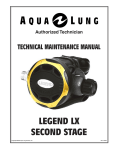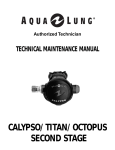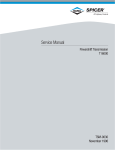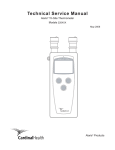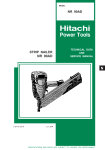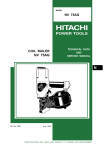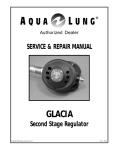Download Aqua Lung LEGEND Service manual
Transcript
Authorized Technician TECHNICAL MAINTENANCE MANUAL LEGEND FIRST STAGE Copyright ©2000 Aqua Lung America, Inc. Rev. 7/2002 2 Legend First Stage Service Manual Contents COPYRIGHT NOTICE...............................................................................................................................................3 INTRODUCTION .......................................................................................................................................................3 WARNINGS, CAUTIONS, & NOTES.........................................................................................................................3 SCHEDULED SERVICE............................................................................................................................................3 GENERAL GUIDELINES ..........................................................................................................................................3 GENERAL CONVENTIONS......................................................................................................................................4 DISASSEMBLY PROCEDURES...............................................................................................................................4 REASSEMBLY PROCEDURES................................................................................................................................7 ADJUSTING THE FIRST STAGE..............................................................................................................................9 FINAL ASSEMBLY .................................................................................................................................................10 TABLE 1 - FIRST-STAGE TROUBLSHOOTING GUIDE.........................................................................................11 TABLE 2 - RECOMMENDED TOOL LIST ..............................................................................................................12 TABLE 3 - RECOMMENDED LUBRICANTS AND CLEANERS...........................................................................13 PROCEDURE A - CLEANING AND LUBRICATION..............................................................................................14 TABLE 4 -TORQUE SPECIFICATIONS..................................................................................................................15 TABLE 5 - TEST BENCH SPECIFICATIONS .........................................................................................................15 LEGEND EXPLODED PARTS DRAWING..............................................................................................................17 3 COPYRIGHT NOTICE An Official Inspection consists of: This manual is copyrighted, all rights reserved. It may not, in whole or in part, be copied, photocopied, reproduced, translated, or reduced to any electronic medium or machine readable form without prior consent in writing from Aqua Lung America. It may not be distributed through the internet or computer bulletin board systems without prior consent in writing from Aqua Lung America. ©2002 Aqua Lung America, Inc. Legend First Stage Service Manual 1. A pressurized immersion test of the entire unit to check for air leakage. 2. Checking for stable intermediate pressure that is within the acceptable range. 3. Checking for opening effort that is within the acceptable range. 4. Checking for smooth operation of the control knob and venturi switch. 5. A visual inspection of the filter for debris or discoloration. INTRODUCTION 6. A visual inspection of the exhaust valve to see that it is in good shape and that it’s resting against a clean surface. 7. A visual inspection of the mouthpiece looking for tears or holes. 8. Pulling back hose protectors and checking that the hoses are secure in the hose crimps. This manual provides factory prescribed procedures for the correct service and repair of the Aqua Lung Legend first-stage regulator. It is not intended to be used as an instructional manual for untrained personnel. The procedures outlined within this manual are to be performed only by personnel who have received factory authorized training through an Aqua Lung Service & Repair Seminar. If you do not completely understand all of the procedures outlined in this manual, contact Aqua Lung to speak directly with a Technical Advisor before proceeding any further. WARNINGS, CAUTIONS, & NOTES Pay special attention to information provided in warnings, cautions, and notes that are accompanied by one of these symbols: If a regulator fails item #1,2,3 or 4 the entire regulator should be overhauled. If a regulator fails 4,5,6 or 7 it will be up to the technician’s discretion whether or not a full overhaul is required. GENERAL GUIDELINES 1. WARNINGS indicate a procedure or situation that may result in serious injury or death if instructions are not followed correctly. CAUTIONS indicate any situation or technique that will result in potential damage to the product, or render the product unsafe if instructions are not followed correctly. F 2. 3. NOTES are used to emphasize important points, tips, and reminders. SCHEDULED SERVICE If the regulator is subjected to less than 50 dives per year, it is permissible to overhaul it every other year with an inspection procedure being performed on the “off” years. For example: Year #1: Inspection; Year #2: Overhaul; Year #3: Inspection Year #4: Overhaul, and so on. Both Inspections and Overhauls need to be documented in the Annual Service & Inspection Record in the back of the Owner’s Manual to keep the Limited Lifetime Warranty in effect. If a regulator is subjected to more than 50 dives per year, it should receive the complete overhaul. 3. 4. In order to correctly perform the procedures outlined in this manual, it is important to follow each step exactly in the order given. Read over the entire manual to become familiar with all procedures before attempting to disassemble the first-stage, and to learn which specialty tools and replacement parts will be required. Keep the manual open beside you for reference while performing each procedure. Do not rely on memory. All service and repair should be carried out in a work area specifically set up and equipped for the task. Adequate lighting, cleanliness, and easy access to all required tools are essential for an efficient repair facility. The regulator body will need to be secured in a vise when removing certain threaded parts, including the inlet fitting (30) and spring retainer (31). NEVER SECURE THE REGULATOR BODY DIRECTLY IN A VISE. Instead, install a vise mounting tool (PN 100395) into the high pressure port, then secure the vise mounting tool in the vise. If you do not have a vise mounting tool, use an EXPIRED CO2 cartridge attached to a high pressure adapter (³₈" female to ⁷₁₆" male). Never screw a CO2 directly into a low pressure port in case the neck of the CO2 cartridge breaks off, leaving the threads stuck in the regulator. As the regulator is disassembled, reusable components should be segregated and not allowed to intermix with nonreusable parts or parts from other units. Delicate parts, including inlet fittings and crowns which contain critical sealing surfaces, must be protected and isolated from other parts to prevent damage during the cleaning procedure. Use only genuine Aqua Lung parts provided in the Legend first-stage overhaul parts kit (PN 900014). DO NOT attempt to substitute an Aqua Lung part with another manufacturer’s, regardless of any similarity in shape or size. 4 5. 6. Legend First Stage Service Manual Do not attempt to reuse mandatory replacement parts under any circumstances, regardless of the amount of use the product has received since it was manufactured or last serviced. When reassembling, it is important to follow every torque specification prescribed in this manual, using a calibrated torque wrench. Most parts are made of either marine brass or plastic, and can be permanently damaged by undue stress. 1. Remove the hoses from the first stage using the appropriate sized wrenches. Install spare HP and MP port plugs into the empty ports, except for one MP port and one HP port. 2. Using your fingers, unscrew the cap (29). Lift off the ribbed washer (26). 3. With your fingers, remove the secondary diaphragm (28). Turn the first stage over so the piston (27) falls out into your hand. 4. With your fingers, stretch the spacer (25) and slide it off the spring retainer (21). 5. Using an 8mm hex wrench, unscrew and remove the adjustment screw (24). Remove the washer (23). Lift out the main spring (22). GENERAL CONVENTIONS Unless otherwise instructed, the following terminology and techniques are assumed: 1. When instructed to remove, unscrew, or loosen a threaded part, turn the part counterclockwise. 2. When instructed to install, screw in, or tighten a threaded part, turn the part clockwise. 3. When instructed to remove an o-ring, use the pinch method (see figure) if possible, or use a brass or plastic o-ring removal tool. Avoid using hardened steel picks, as they may damage the o-ring sealing surface. All o-rings that are removed are discarded and replaced with brand new o-rings. 4. The following acronyms are used throughout the manual: MP is Medium Pressure; HP is High Pressure; IP is Intermediate Pressure. 5. Numbers in parentheses reference the key numbers on Pinch Method Press upwards on sides of oring to create protrusion. Grab o-ring or insert o-ring tool at protrusion to remove. the exploded parts schematics. For example, in the statement, "...remove the o-ring (8) from the...", the number 8 is the key number to the crown o-ring. DISASSEMBLY PROCEDURES Before performing any disassembly, refer to F Note: the exploded parts drawing, which references all mandatory replacement parts. These parts should be replaced with new, and must not be reused under any circumstances - regardless of the age of the regulator or how much use it has received since it was last serviced. CAUTION: Use only a plastic or brass o-ring removal tool (PN 944022) when removing orings to prevent damage to the sealing surface. Even a small scratch across an o-ring sealing surface could result in leakage. Once an o-ring sealing surface has been damaged, the part must be replaced with new. DO NOT use a dental pick, or any other steel instrument. 5 The washer may be inside the adjustment F Note: screw. If so, gently tap the adjustment screw 8. Using an 8mm hex wrench, unscrew the HP plug (1). Turn the reglator over so the spring (5) and HP seat (6) fall out into your hand. Separate the spring from the HP seat. 9. Remove the o-ring (2) from the HP plug (1). Using a brass o-ring tool, remove the o-ring (4) and backup ring (3) from inside the HP plug. against the work bench and the washer will fall out. 6. 7. Install a vise mounting tool (pn 100395) into one of the HP ports. Secure the vise mounting tool in a bench vise with the spring retainer (21) facing upward. Using a 32mm open-end wrench, unscrew the spring retainer from the body. Lift out the spring pad (20). Using a brass O-ring tool, remove the thrust washer (19b). Remove the firststage from the vise. To remove the diaphragm (19a), insert a low pressure air nozzle into the open MP port. While holding your thumb over the diaphragm, inject a small blast of air into the MP port to pop out the diaphragm. Lift out the pin support (18). Turn the regulator over and allow the pin (7) to fall out into your hand. CAUTION: Before proceeding, make sure you are woking over a padded work surface; otherwise, the crown (9) may be damaged during removal. 10. Insert the pin-end of seat extractor tool (pn 109436) into the center hole on the low pressure side (diaphragm side) of the first stage body. While keeping the pin slightly tilted, press inward to remove the crown (9). Remove the o-ring (8) from the crown. 6 Legend First Stage Service Manual If the first-stage has a yoke, go to step 11A; if it has a DIN connector, go to step 11B. 12. Loosen the vise and remove the first stage. Remove the vise mounting tool from HP port. Using a 4mm hex wrench, remove all the port plugs (15 & 17) and their o-rings (14 & 16). 13. Pull on the narrow end of the protective sheath (11) and slide it off the body (10). 11A. Removing the Yoke a. Secure the vise mounting tool into a bench vise with the yoke facing upward. Unscrew the yoke screw (34) and remove the dust cap (35) from the yoke screw. Using a large (15") adjustable wrench, unscrew the inlet fitting (30). Loosen the vise and remove the first stage. Remove the vise mounting tool from HP port. b. Using circlip pliers, squeeze the c-clip (32) and remove it from the inlet fitting. Turn over the inlet fitting and allow the filter shield (31) to fall out into your hand. c. Insert the plastic end of the seat extractor tool into the open end of the inlet fitting and push out the filter (12). Remove the filter o-ring (13). 11B. Remove the DIN fitting a. Secure the vise mounting tool into a bench vise with the DIN adapter facing upward. Remove the protective DIN cap (36). Using a 6mm hex wrench, unscrew the DIN connector (38). Remove the handwheel (39). b. Using an 1/8" wooden dowel or similar sized tool, push the filter (12) out of the DIN connector. Remove the filter o-ring (13). c. Remove the o-ring (37) from the face of the DIN connector. This Ends Disassembly Before starting reassembly, perform parts cleaning and lubrication according to the procedures outlined in Procedure A, titled Cleaning & Lubrication, on page 14. 7 REASSEMBLY PROCEDURES 1. Slide the protective sheath (11) on the first stage body (10). Make sure all the ports and inlet fitting opening align with the holes in the sheath. 2. Install new, lubricated o-rings (14 & 16) on all the port plugs (15 & 17). Install all the port plugs, except for one HP port, and tighten them using a 4mm hex wrench. 3. 4. Install the new backup ring into the HP plug (1) with the concave side facing outward. Install a new, lubricated oring (4) into the HP plug, against the backup ring. Visually inspect the o-ring to make sure it is seated evenly. 5. Install a new, lubricated o-ring (2) onto the HP plug (1). 6. Drop a new HP seat (6), blue sealing side first, into the first stage. Inspect the seat to make sure it is standing straight. Place the spring (5) over the seat. 7. Insert an 8mm hex wrench into the HP plug. Insert the plug into the first stage body. Push down on the plug to compress the spring while at the same time turning clockwise to screw it into the body. Tighten the HP plug until it stops turning. Attach an 8mm hex key to a torque wrench. Tighten the HP plug to 43-45 inch-pounds. Install a new, lubricated o-ring (8) onto the crown (9). Slide the crown onto the seat installation tool with the sealing edge against the plastic handle. Insert the crown into the body and press it into place. Use the blunt end of the seat installation tool to make sure the crown is properly seated. Before proceeding, closely examine the F NOTE: new backup ring (3). You will notice that one side is flat and one side is concave. When properly installed, the concave side will be against the o-ring (4) as shown in the illustration below. O-ring Backup Ring 8 8. 9. Legend First Stage Service Manual Turn the regulator over so the medium pressure side is facing upward. Drop the pin (7) through the center hole. Place the pin support (18) over the pin. Press on the pin support a few times. It should feel like a spring-loaded button. Press a new diaphragm (19a) into the first stage body. Run your finger around the edge of the diaphragm to make sure it is properly seated. Install the thrust washer (19b) on top of the diaphragm and make sure it is seated flat against the diaphragm. 12. Screw a vise mounting tool into the open HP port and secure it in a vise with the spring retainer facing upward. Attach a 32mm crows-foot to a foot-pound torque wrench. Tighten the spring retainer to 18-20 foot-pounds. 13. Using an 8mm wrench, tighten the adjustment screw (24) until there are 2 to 3 threads still visible above the inside ledge of the spring retainer. 37 If the first-stage has a yoke, go to step 14A; if it has a DIN connector, go to step 14B. 14A. Installing the Yoke: 10. 11. a. Insert the conical end of the filter (12) into the threaded end of the inlet fitting (30). Install a new, lubricated o-ring (13) into the end of the inlet fitting, around the filter. b. Place the filter shield (31) into the end of the inlet fitting. Using circlip pliers, compress the c-clip (32) and install it into the inlet fitting. Inspect the c-clip to make sure it is properly seated. c. Remove the first-stage from the vise. Hold the first-stage with the inlet opening facing downward. Pass the inlet fitting (30) through the yoke (33) and screw it into the first stage body until finger tight. Secure the first-stage back in the vise with the yoke facing upward. Place the special inlet socket (pn 111001) over the inlet fitting. Attach Place the spring pad (20), flat side down, in the center of the diaphragm. Set the main spring (22) on the spring pad. Place the washer (23) on top of the spring. Thread the adjustment screw (24) into the spring retainer (21) until the first two threads are engaged. Thread the spring retainer onto the body until hand tight. 9 a socket extension to a foot-pound torque wrench. Pass the socket extension through the top of the yoke and insert it into the socket. Tighten the inlet fitting to 18-20 foot-pounds. Remove the torque wrench and socket. d. c. Remove the first-stage from the vise. Hold the firststage with the inlet opening facing downward. Insert the threaded end of the DIN connector through the threaded side of the handwheel (39) and screw it into the first stage body until finger tight. Secure the first-stage back in the vise with the DIN connector facing upward. Screw the DIN connector into the body (10). Attach a 6mm hex key to a foot-pound torque wrench. Tighten the DIN connector to 18-20 foot-pounds. 15. Loosen the vise and remove the first-stage. Remove the vise mounting tool and reinstall the HP port plug. Slide the dust cap (35) over the yoke knob threads with the Aqua Lung logo facing outward. Thread the yoke screw (34) into the yoke. ADJUSTING THE FIRST STAGE 14B. Installing the DIN Adapter a. b. 1. Attach a LP test gauge (0 to 400 psig) to a low pressure hose and thread the hose into the open MP port. If your test gauge does not have an over-pressure relief valve, you must also attached a properly adjusted secondstage to the first stage to act as the relief valve in case of a HP leak. 2. Attach the first stage to a fully charged (2500 to 3000 psi) cylinder. Slowly open the cylinder valve to pressurize the cylinder. Install a new o-ring (37) into the face of the DIN connector. Insert the conical end of the filter (12) into the threaded end of the DIN connector (38). Install a new, lubricated o-ring (13) into the end of the DIN connector, around the filter. CAUTION: If the pressure gauge rapidly exceeds 140 psi, then there is a HP leak. Quickly close the cylinder valve and purge the regulator. Refer to the troubleshooting table for the causes of HP leaks. 3. Assuming there are no leaks, adjust the medium pressure by turning the adjustment screw: Turning in the adjustment screw increases the MP; turning out the adjustment screw decreases the MP. Turn the adjustment screw in ¹₈th turn increments and cycle the relief valve several times after each adjustment. When the MP is 135 psi, cycle the gauge relief valve on and off 10-15 times. After cycling, watch the gauge needle. The first stage MP should "lock-up" at 135 psi. Make any adjustments as necessary. Allow the first-stage to stay pressurized for several minutes and check the MP again to make sure it remains "locked-up" at 135 psi. If the MP creeped upward more than 3 psi, then there is a leak. Refer to the troubleshooting table for possible causes. 10 4. Legend First Stage Service Manual Close the cylinder valve and depressurize the regulator by opening the gauge relief valve or by pressing the second stage purge button. Close the gauge relief valve and repressurize the system. The MP should still read 135 psi. If the pressure reading is different than the original setting, repeat steps 3 and 4 until the MP is stable. FINAL ASSEMBLY 1. Orient the spacer (25) so the side with straight edges is facing upward. Align the straight edges of the spacer (25) with the wrench flats on the spring retainer. Work the spacer over the spring retainer until it sits against the body. Place the ribbed washer (26) on top of the spacer Steps 2 and 3 must be performed while F NOTE: the regulator is still pressurized. 2. With the regulator still pressurized, insert the piston (27) into the dry chamber. With the cupped side of the secondary diaphragm (28) facing downward, insert the edge of the diaphragm into the outer groove in the spring retainer (21). 3. Thread the end cap (29) onto the dry chamber until handtight. Recheck the medium pressure to make sure it is still at 135 psig. 4. Close the cylinder valve and depressurize the regulator. Remove the test gauge and reinstall the port plug(s). This Ends Resassembly 11 Table 1 - Troubleshooting Guide SYMPTOM High pressure creep (also causes second-stage leaks) External air leakage -0rSecondary diaphragm distended or burst Restricted air flow or high inhalation resistance through entire system POSSIBLE CAUSE TREATMENT 1. HP Seat (6) is worn or damaged 1. Replace HP seat 2. Crown (9) damaged. 2. Replace crow 3. O-ring (4) damaged or worn. 3. Replace O-ring 4. HP plug (1) internal wall damaged 4. Replace HP plug 5. O-ring (8) damaged or worn 5. Replace O-ring 6. Body to crown sealing area damaged 6. Replace Body 1. Port plug o-rings (14 & 16) worn or damaged 1. Replace o-rings 2. Diaphragm (28) worn or damaged 2. Replace diaphragm 3. Diaphragm (19a) worn or damaged 3. Replace diaphragm 4. Diaphragm seating surface damaged 4. Replace body 5. Spring retainer (21) loose 5. Tighten spring retainer 6. Inlet fitting O-ring (13) worn or damaged 6. Replace o-ring 7. HP Plug o-ring (2) worn or damaged 7. Replace o-ring 1. Cylinder valve not completely open 1. Open valve; check fill pressure 2. Cylinder valve needs service 2. Switch to different cylinder 3. Filter (12) is clogged 3. Replace filter 12 Legend First Stage Service Manual Table 2 - Recommended Tool List PART NO. DESCRIPTION APPLICATION 111610 I.P. test gauge Intermediate pressure testing 944022 O-ring tool, set O-ring removal and installation 111100 Reversible snap ring pliers Circlip removal 109436 Seat extract/install tool HP seat removal 100395 Vise mounting tool Mounting first-stage into vise 111001 Yoke nut socket Inlet fitting n/a Torque wrench, foot-pound Inlet fitting, spring retainer, HP Plug n/a Socket Extension Socket n/a 15" adjustable Inlet Fitting n/a 4mm hex wrench Port plugs n/a 8mm hex wrench IP adjustment, HP Plug (removal) n/a 8mm hex key HP Plug (installation w/torque wrench) n/a 6mm hex wrench DIN Connector (removal) n/a 6mm hex key DIN Connector (installation w/torque wrench) 13 Table 3 - Recommended Lubricants & Cleaners LUBRICANT / CLEANER Christo-Lube® MCG-111 APPLICATION All O-rings seals SOURCE Aqua Lung, PN 820466, or Lubrication Technologies 310 Morton Street Jackson, OH 45640 (800) 477-8704 CAUTION: Silicone rubber requires no lubrication or preservative treatment. DO NOT apply grease or spray to silicone rubber parts. Doing so may cause a chemical breakdown and premature deterioration of the material. Oakite #31 Acid bath for reusable stainless steel and brass parts. Oakite Products, Inc. 50 Valley Road Berkeley Heights, NJ 07922 White distilled vinegar (100 gr.) Acid bath for reusable stainless steel and brass parts. "Household" grade CAUTION: DO NOT use muriatic acid for the cleaning of any parts. Muriatic acid, even when strongly diluted, can harm chrome plating, and may leave a residue that is harmful to O-ring seals and other parts. Liquid dishwashing detergent (diluted with warm water) Degreaser for brass and stainless steel parts; general cleaning solution for plastic and rubber "Household" grade 14 Legend First Stage Service Manual Procedure A Cleaning & Lubrication (All Aqua Lung Regulators) Brass and Stainless Steel Parts 1. Preclean in warm, soapy water* using a nylon bristle tooth brush. 2. Thoroughly clean parts in an ultrasonic cleaner filled with soapy water. If there are stubborn deposits, houshold white distilled vinegar (acetic acid) in an ultrasonic cleaner will work well. DO NOT place plastic, rubber, silicone or anodized aluminum parts in vinegar. 3. Remove parts from the ultrasonic cleaner and rinse with fresh water. If tap water is extremely “hard,” place the parts in a bath of distilled water to prevent any mineral residue. Agitate lightly, and allow to soak for 5-10 minutes. Remove and blow dry with low pressure (25 psi) filtered air, and inspect closely to ensure proper cleaning and like-new condition. Anodized Aluminum, Plastic & Rubber Parts Anodized aluminum parts and parts made of plastic or rubber, such as box bottoms, box tops, dust caps, etc., may be soaked and cleaned in a solution of warm water mixed with mild dish soap. Use only a soft nylon toothbrush to scrub away any deposits. Rinse in fresh water and thoroughly blow dry, using low pressure filtered air. CAUTION: Do not place plastic and rubber parts in acid solutions. Doing so my alter the physical properties of the component, causing it to prematurely degrade and/or break. Hoses If buildup of corrosion is severe, it is permissible to soak only the hose fittings in the ultrasonic cleaner as needed, and not allow any solution to enter the hose. Rinse in fresh water and allow to dry with the cleaned ends hanging down. Blow filtered air through them prior to installing onto the regulator. Lubrication and Dressing All o-rings should be lubricated with Christo-Lube® MCG-111. Dress the o-rings with a very light film of grease, and remove any visible excess by running the o-ring between thumb and forefinger. Avoid applying excessive amounts of Christo-Lube grease, as this will attract particulate matter that may cause damage to the o-ring. *Soapy water is defined as "household" grade liquid dishwashing detergent diluted in warm water. 15 Table 4 - Torque Specifications PART NUMBER DESCRIPTION (KEY NUMBER) TORQUE 716021 Spring retainer (21) 25±2 foot-lbs 716018 Inlet Fitting (30) 20±2 foot-lbs 124602 DIN Connector (38) 20±2 foot-lbs 129120 HP Plug (1) 43-45 inch-pounds HP Port Plug (15), LP Port Plug (17) 16-18 inch-pounds 129118, 129119 Table 5 - Test Bench Specifications TEST CONDITION ACCEPTABLE RANGE Leak Test Inlet 2,500-3,000 (±100) psig No leaks allowed Medium Pressure Inlet 2,500-3,000 (±100) psig 135±5 psi Medium Pressure Creep Inlet 2,500-3,000 (±100) psig 5 psi max between 5 to 15 seconds after cycling (purging) regulator 16 Legend First Stage Service Manual TECHNICIAN'S NOTES 17 Legend Exploded Parts Drawing Key # Part # ------ 129060 ------ 900014 1 ----- 129120 2 ----- 824407 3 ----- 119129 4 ----- 820080 5 ----- 122244 6 ----- 105940 7 ----- 102002 8 ----- 820038 9 ----- 106027 10 ---- 129111 11 ---- 129112 12 ---- 129151 13 ---- 820011 14 ---- 820072 15 ---- 129118 16 ---- 820011 17 ---- 129119 18 ---- 129121 19 ---- 103425 20 ---- 124560 21 ---- 129122 22 ---- 106356 Description First Stage Complete Overhaul Parts Kit (Yoke and DIN) HP Plug O-ring Backup ring O-ring Spring HP Seat Pin O-ring Crown Body Sheath Filter O-ring O-ring, HP Port Port Plug, HP O-ring, LP Port Port Plug, MP Pin Support Diaphragm Kit (includes thrust washer) Spring Pad Spring Retainer Main Spring Key # Part # 23 ---- 845097 24 ---- 106026 25 ---- 129128 26 ---- 129127 27 ---- 129123 28 ---- 129126 29 ---- 129114 30 ---- 129124 31 ---- 129149 32 ---- 863051 33 ---- 124613 ------ 106843 34 ---- 107507 35 ---- 124555 36 ---- 107441 37 ---- 820094 38 ---- 129125 39 ---- 129117 Description Washer Adjustment Screw Spacer Ribbed Washer Piston Diaphragm, Secondary Cap Inlet Fitting Shield C-Clip Yoke, Black Chrome Yoke, Satin Chrome Yoke Screw Dust Cap DIN Cap O-ring DIN Fitting DIN Handwheel Part numbers in BOLD ITALICS indicate standard overhaul replacement part. 2340 Cousteau Court, Vista, California 92083 www.aqualung.com Rev. 7/2002



















